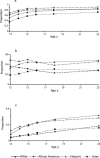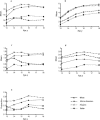From adolescence to young adulthood: racial/ethnic disparities in smoking
- PMID: 14759945
- PMCID: PMC1448246
- DOI: 10.2105/ajph.94.2.293
From adolescence to young adulthood: racial/ethnic disparities in smoking
Erratum in
- Am J Public Health. 2004 Apr;94(4):520
Abstract
Objectives: We used data gathered from 6259 youths between the ages of 13 and 23 years to compare trends in smoking among 4 racial/ethnic groups.
Methods: We weighted trend data to represent baseline respondent characteristics and evaluated these data with linear contrasts derived from multiple regression analyses.
Results: Although African Americans exhibited higher initiation rates than Whites, they exhibited consistently lower rates of regular smoking than both Whites and Hispanics. This seeming anomaly was explained by African Americans' lower rates of transition to regular smoking and greater tendency to quit. Racial/ethnic disparities were accounted for by differences in pro-smoking influences.
Conclusions: Reducing racial/ethnic disparities in smoking may require reducing differences in the psychosocial factors that encourage smoking.
Figures


Similar articles
-
Do the majority of Asian-American and African-American smokers start as adults?Am J Prev Med. 2004 Feb;26(2):156-8. doi: 10.1016/j.amepre.2003.10.008. Am J Prev Med. 2004. PMID: 14751329
-
Receptivity to protobacco media and its impact on cigarette smoking among ethnic minority youth in California.J Health Commun. 2002 Mar-Apr;7(2):95-111. doi: 10.1080/10810730290087987. J Health Commun. 2002. PMID: 12049425
-
Tobacco, alcohol, and illicit drug use: racial and ethnic differences among U.S. high school seniors, 1976-2000.Public Health Rep. 2002;117 Suppl 1(Suppl 1):S67-75. Public Health Rep. 2002. PMID: 12435829 Free PMC article.
-
Disparities in Adult Cigarette Smoking - United States, 2002-2005 and 2010-2013.MMWR Morb Mortal Wkly Rep. 2016 Aug 5;65(30):753-8. doi: 10.15585/mmwr.mm6530a1. MMWR Morb Mortal Wkly Rep. 2016. PMID: 27491017
-
State-specific prevalence of selected health behaviors, by race and ethnicity--Behavioral Risk Factor Surveillance System, 1997.MMWR CDC Surveill Summ. 2000 Mar 24;49(2):1-60. MMWR CDC Surveill Summ. 2000. PMID: 10965781
Cited by
-
Indoor air pollution and risk of lung cancer among Chinese female non-smokers.Cancer Causes Control. 2013 Mar;24(3):439-50. doi: 10.1007/s10552-012-0130-8. Epub 2013 Jan 12. Cancer Causes Control. 2013. PMID: 23314675 Free PMC article.
-
Examination of the Involvement of Cholinergic-Associated Genes in Nicotine Behaviors in European and African Americans.Nicotine Tob Res. 2017 Apr 1;19(4):417-425. doi: 10.1093/ntr/ntw200. Nicotine Tob Res. 2017. PMID: 27613895 Free PMC article.
-
Integrated schools, segregated curriculum: effects of within-school segregation on adolescent health behaviors and educational aspirations.Am J Public Health. 2010 Sep;100(9):1687-95. doi: 10.2105/AJPH.2009.179424. Epub 2010 Jul 15. Am J Public Health. 2010. PMID: 20634462 Free PMC article.
-
Examining unsupervised time with peers and the role of association with delinquent peers on adolescent smoking.Nicotine Tob Res. 2009 Apr;11(4):371-80. doi: 10.1093/ntr/ntp003. Epub 2009 Mar 23. Nicotine Tob Res. 2009. PMID: 19307446 Free PMC article.
-
What predicts sex partners' age differences among African American youth? A longitudinal study from adolescence to young adulthood.J Sex Res. 2010 Jul;47(4):330-44. doi: 10.1080/00224490903015850. J Sex Res. 2010. PMID: 19517294 Free PMC article.
References
-
- Centers for Disease Control and Prevention. Tobacco use among high school students—United States, 1997. J Sch Health. 1998;68:202–204. - PubMed
-
- Epstein J, Botvin G, Diaz T. Ethnic and gender differences in smoking prevalence among a longitudinal sample of inner-city adolescents. J Adolesc Health. 1998;23:160–166. - PubMed
-
- Johnston LD, O’Malley PM, Bachman JG. Monitoring the Future: National Survey Results on Drug Use, 1975–2001, Volume 1: Secondary School Students. Bethesda, Md: National Institute on Drug Abuse; 2002. NIH publication 02-5106.
-
- Kopstein A. Tobacco Use in America: Findings From the 1999 National Household Survey on Drug Abuse. Rockville, Md: Substance Abuse and Mental Health Services Administration; 2001. DHHS publication SMA02-3622.
Publication types
MeSH terms
LinkOut - more resources
Full Text Sources
Medical

